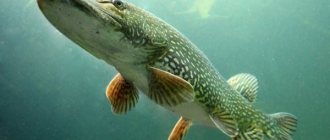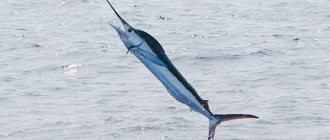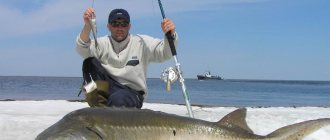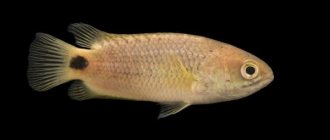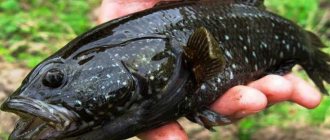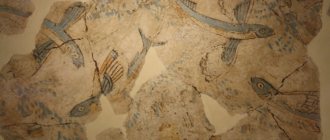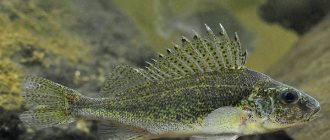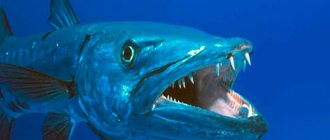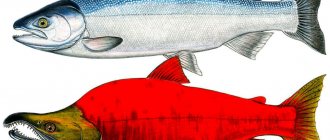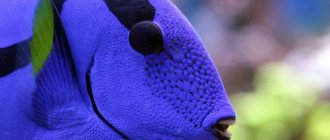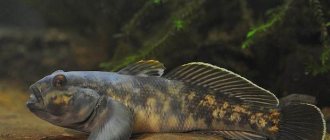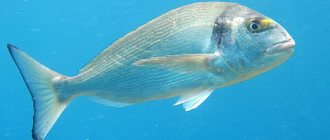- Wild animals
- >>
- Fish
Coelacanth is the only representative of the ancient order of coelacanths that has survived to this day. That is why it is unique - its inherent features are no longer identified, and its study reveals the mysteries of evolution, because it is very similar to the ancestors who sailed the seas of the Earth in ancient times - even before reaching land.
Origin of the species and description
Photo: Coelacanth
Coelacanths appeared about 400 million years ago and this order was once numerous, but only one genus, including two species, has survived to this day. Therefore, coelacanths are considered relict fish - a living fossil.
Previously, scientists believed that over all these years coelacanths have undergone almost no changes, and we see them the same as they were in ancient times. But after genetic studies, it was found that they are evolving at a normal speed - and it also turned out that they are closer to tetrapods than to fish.
Coelacanths (colloquially coelacanths, although scientists call only one of the genera of these fish that way) have a very long history and gave rise to many different forms: the sizes of the fish belonging to this order ranged from 10 to 200 centimeters, they had bodies of various shapes - from wide to eel-shaped, the structure of the fins was very different and there were other characteristic features.
Video: Coelacanth
From the notochord, they developed an elastic tube, very different from that of other fish; the structure of the skull is also specific - there are no other animals with a similar one on Earth. Evolution has brought coelacanths very far - which is why, even having lost their status as fish that have not changed over the centuries, coelacanths have retained enormous scientific value.
The peak of the distribution of coelacanths on our planet is believed to have occurred during the Triassic and Jurassic periods. They contain the largest number of archaeological finds. Immediately after reaching this peak, most of the coelacanths became extinct - in any case, there are simply no later finds.
They were thought to have gone extinct long before the dinosaurs. All the more surprising for scientists was the discovery: they are still found on the planet! It happened in 1938, and a year later the species Latimeria chalumnae received a scientific description, it was done by D. Smith.
They began to actively study coelacanths and established that they live near the Comoros Islands, but even so, for another 60 years they did not suspect that in a completely different part of the world, in the seas off Indonesia, a second species, Latimeria menadoensis, lives. Its description was made in 1999 by a group of scientists.
Area
Until 1997, only the southwest Indian Ocean (centered on the Comoros Islands) was considered the distribution area of coelacanth, but after the discovery of the second species ( L. menadoensis
) it turned out that the range of the genus is fragmented with a distance between parts of approximately 10,000 km (see map). The specimen, which was caught near the mouth of the Chalumna River in 1938, was later determined to be an introduction from the Comorian population, from the area of the Grande Comore or Anjouan islands. Catches in the Malindi area (Kenya) and the presence of a permanent population in Sodwana Bay (South Africa) have expanded the range of the Comorian coelacanth along the South African coast. The origin of coelacanths caught off the coast of Mozambique and southwestern Madagascar from the Comorian population has been reliably established.
Appearance and features
Photo: Coelacanth fish
The Comorian species is blue-gray in color and has many large light gray spots on its body. This is how they are distinguished - each fish has its own pattern. These spots resemble tunicates that live in the same caves as the coelacanths themselves. This coloring allows them to camouflage themselves. After death they turn brown, which is the normal color for the Indonesian species.
Females are larger than males, they can grow up to 180-190 cm, while males can grow up to 140-150. They weigh 50-85 kilograms. Once a fish is born, it is already quite large, about 40 cm - this discourages many predators from even interested in fry.
The skeleton of the coelacanth is very similar to that of its fossil ancestors. The lobed fins are noteworthy - there are eight of them, the paired ones have bony girdles, from which the shoulder and pelvic girdles of vertebrates developed in ancient times after reaching land. The evolution of the notochord in coelacanths proceeded in its own way - instead of vertebrae, they had a rather thick tube containing liquid under high pressure.
The design of the skull is also unique: the internal joint divides it into two parts, as a result, the coelacanth can lower the lower jaw and raise the upper one - due to this, its mouth opening is larger and the suction efficiency is higher.
The brain of coelacanths is very small: it weighs only a few grams, and it occupies one and a half percent of the fish’s skull. But they have a developed epiphyseal complex, due to which they have good photoreception. Large luminous eyes also contribute to this - they are well adapted to life in the dark.
Coelacanth also has many other unique features - it is a very interesting fish to study, in which researchers are discovering new features that can shed light on some of the secrets of evolution. Indeed, in many respects, it is almost the same as the ancient fish from times when there was no highly organized life on land at all.
Using her example, scientists can see how ancient organisms worked, which is much more effective than studying fossil skeletons. Moreover, their internal organs are not preserved at all, and before the discovery of coelacanth one could only guess how they might be structured.
Interesting fact: The coelacanth's skull has a gelatinous cavity, thanks to which it is able to detect even small fluctuations in the electric field. Therefore, she does not need light to sense the exact location of the victim.
Where does coelacanth live?
Photo: Coelacanth fish
There are three main areas of its habitat:
- the Mozambique Channel, as well as the territory slightly to the north;
- off the coast of South Africa;
- next to the Kenyan port of Malindi;
- Sulawesi sea.
Perhaps the matter is not limited to this, and she still lives in some remote part of the world, because the last area of her habitat was discovered quite recently - in the late 1990s. At the same time, it is very far from the first two - and therefore nothing prevents another species of coelacanth from being discovered on the other side of the planet.
First of all, about 80 years ago, coelacanth was discovered at the confluence of the Chalumna River into the ocean (hence the name of this species in Latin) near the coast of South Africa. It quickly became clear that this specimen was brought from another place - the Comoros region. It is next to them that coelacanth lives most of all.
But later it was discovered that there is still a population of its own off the coast of South Africa - they live in Sodwana Bay. Another one was found off the coast of Kenya. Finally, a second species was discovered, living at a great distance from the first, in another ocean - near the island of Sulawesi, in the sea of the same name, in the Pacific Ocean.
Difficulties in detecting coelacanth are due to the fact that it lives at depth, and exclusively in warm tropical seas, the coasts of which are usually rather poorly developed. This fish feels best when the water temperature is approximately 14-18 °C, and in the areas it inhabits, this temperature is at a depth of 100 to 350 meters.
Since food at such depths is quite scarce, at night the coelacanth can rise higher to have a snack. During the day, it dives again or even goes to rest in underwater caves. Accordingly, they choose habitats where such caves are easy to find.
This is why the surroundings of the Comoros Islands are so popular - due to long-standing volcanic activity, many underwater voids have appeared there, which is very convenient for coelacanths. There is one more important condition: they live only in those places where fresh water enters the sea through these caves.
Now you know where the coelacanth fish lives. Let's see what she eats.
More interesting facts
Coelacanths are inedible, but many people want to get this amazing fish for their private collection. Considering that catching coelacanths is prohibited, the authorities of some countries have specially equipped fishermen with motor boats. This was done to ensure that commercial fish were caught at great depths, and the likelihood of catching coelacanth was minimized.
These were all the interesting facts about coelacanth that we prepared for you. If you liked the article, don't forget to share it with your friends. Also write in the comments what else you would like to know about.
The article was read by 9,954
What does coelacanth eat?
Photo: Modern coelacanth
This is a predatory fish, but it swims slowly. This predetermines her diet - it mainly consists of small animals that are not able to swim away even from her.
This:
- medium-sized fish – birchfish, snappers, cardinals, eels;
- cuttlefish and other molluscs;
- anchovies and other small fish;
- small sharks.
Coelacanths look for food in the same caves where they live most of the time, swimming near their walls and sucking in prey lurking in the voids - the structure of the skull and jaws allows them to suck in food with great force. If there is not enough of it, and the fish feels hungry, then at night it swims out and looks for food closer to the surface.
It can grab large prey - this is what its teeth are designed for, albeit small ones. For all its slowness, if the coelacanth has already captured its prey, it will be difficult to escape - this is a strong fish. But its teeth are not suitable for biting and tearing meat, so it has to swallow the victim whole.
Naturally, it takes a long time to digest, for which reason the coelacanth has a well-developed spiral valve - a specific organ inherent in only a few orders of fish. It takes a long time to digest, but it allows you to eat almost anything without negative consequences.
Interesting fact: Living coelacanth can only be studied underwater - when rising to the surface, respiratory stress occurs due to too warm water, and it dies even if it is quickly placed in the usual cool water.
Features of character and lifestyle
Photo: Coelacanth from the Red Book
The coelacanth spends the day in a cave, resting, but at night they go out hunting, and can either sink deeper into the water column or, on the contrary, rise. They do not spend a lot of energy on swimming: they try to ride the current and allow it to carry them, and with their fins they only set the direction and go around obstacles.
Although the coelacanth is a slow-moving fish, the structure of its fins is a very interesting feature to study; they allow it to swim in an unusual way. First, she needs to accelerate, for which she hits the water with force with her paired fins, and then soars through the water rather than swims through it - the difference from most other fish when moving is striking.
The first dorsal fin serves as a kind of sail, and the caudal fin is motionless most of the time, but if the fish is in danger, it can use it to make a sharp jerk. If she needs to turn, she presses one pectoral fin to her body and straightens the other. There is little grace in the movement of the coelacanth, but it uses its strength very sparingly.
This is generally the main thing in the character of the coelacanth: it is rather sluggish and uninitiative, generally not aggressive, and all the efforts of the body of this fish are aimed at saving resources. And in this evolution has made significant progress!
Social structure and reproduction
Photo: Coelacanth
During the day, coelacanths gather in caves in groups, but there is no single pattern of behavior: as researchers have established, some individuals constantly gather together in the same caves, while others swim to different ones each time, thus changing the group. What causes this has not yet been established.
Coelacanths are ovoviviparous; embryos even before birth have teeth and a developed digestive system - researchers believe that they feed on excess eggs. These thoughts are suggested by several caught pregnant females: in those whose pregnancy was in the early stages, 50-70 eggs were found, and in those whose embryos were close to birth, there were much fewer of them - from 5 to 30.
Embryos also feed by absorbing intrauterine milk. The reproductive system of fish is generally well developed, allowing the birth of already formed and fairly large fry that can immediately fend for themselves. Pregnancy lasts more than a year.
And sexual maturity occurs by the age of 20, after which reproduction occurs once every 3-4 years. Fertilization is internal, although scientists do not yet know the details. It is also not established where the young coelacanths live - they do not live in caves with older ones; during the entire period of research, only two were found, and they simply swam in the sea.
Natural enemies of coelacanths
Photo: Coelacanth fish
Adult coelacanth is a large fish and, despite its slowness, is able to defend itself. Of the neighboring inhabitants of the oceans, only large sharks can deal with it without any problems. That’s why coelacanths are the only ones who are afraid of them – after all, sharks eat almost everything that catches their eye.
Even the specific taste of coelacanth meat, which strongly smacks of rotten meat, does not bother them at all - after all, they are not averse to eating real carrion. But this taste in some way contributed to the preservation of coelacanths - people living near their habitats, unlike scientists, knew about them for a long time, but almost did not eat them.
But sometimes they still ate it, because they believed that coelacanth meat was effective against malaria. In any case, they were not actively fished, so the population probably remained at about the same level. They suffered seriously at a time when a real black market was formed, where liquid from their unusual chord was sold.
Interesting fact: The ancestors of coelacanths had full-fledged lungs, and their embryos still have them - but as the embryo grows, the development of its lungs progresses more and more slowly, and as a result they remain underdeveloped. The coelacanth simply ceased to need them after it began to live in deep waters - at first, scientists mistook these underdeveloped remnants of the lung for the swim bladder of a fish.
blue fish
The strange animal, Latimer reported, was part of the catch of fishermen from the trawler Nerin. It was caught in a net off the South African coast near the Chalumna River on December 21, 1938. The fish spent several hours on the deck of the ship. Captain Hendrik Goosen considered the pale blue animal, one and a half meters long, inedible. And even unpleasant. But still decided to leave him on board. To sell it to Miss Latimer. Who often bought unusual fish for the museum collection.
Latimer barely went down to the fishing docks that day. Because it was hot. And in general, she was very busy. But some kind of premonition forced her to approach the fishermen. And, as it turned out, not in vain. She saw a strange blue fish on the deck of the trawler. And, as she later stated, it was “the most beautiful fish I have ever seen...”. Latimer bought the corpse of the unfortunate animal and took it with her. After a quarrel with a taxi driver who did not want to carry the smelly carcass in his car, the heroic woman somehow, apparently dragging the fish by the tail, finally made it to the museum.
However, as soon as she was in place, an amazing thing suddenly became clear. It turned out that the museum did not have refrigeration equipment in which to store such a large sample. But the local cold storage warehouse and morgue flatly refused to cooperate. Because there is no point in setting up a fish store here. So the researcher turned to a local taxidermist. This allowed the animal and its entrails to be preserved as best as possible. After all this, she sat down at the table and wrote a letter to Smith. In which she told him her wonderful story. And she even attached a sketch of an unusual animal to the letter.
Population and species status
Photo: Coelacanth fish
The Indonesian species is considered vulnerable, and the Comorian species is considered critically endangered. Both are protected and fishing is prohibited. Before the official discovery of these fish, although the local population of coastal areas knew about them, they did not specifically catch them, since they did not eat them.
After the discovery, this continued for some time, but then a rumor spread that the liquid extracted from their chord could prolong life. There were others - for example, that they could be used to make a love potion. Then, despite the bans, they began to be actively caught, because the prices for this liquid were very high.
Poachers were most active in the 1980s, as a result of which researchers discovered that the population had declined very dramatically, to critical levels - according to their assessment, only 300 coelacanths remained in the Comoros region by the mid-1990s. Thanks to measures against poachers, their numbers were stabilized, and now they are estimated at 400-500 individuals.
How many coelacanths live off the coast of South Africa and in the Sulawesi Sea has not yet been established, even approximately. It is assumed that there are few of them in the first case (it is unlikely that we are talking about hundreds of individuals). In the second, the spread can be very large - approximately from 100 to 1,000 individuals.
Why is it a fossil?
After active illegal fishing of individuals, the population of ancient creatures has decreased significantly. Illegal fishing has become a big problem for ichthyologists. For many years now, the creature has been classified as an object listed in the Red Book. Scientists call it a unique species that is at a critical level of extinction.
At the moment, researchers cannot say with certainty how many individuals there are in the population. The analysis is hampered by the deep-sea lifestyle of ocean inhabitants.
The fish in question are valuable research objects in scientific laboratories around the world. As a result of long-term observation of their lives, as well as through the study of their body structure, new incredible facts about the evolution of ancient creatures are discovered every year. Recently, no cases of illegal fishing or sale of individuals of this species have been identified.
